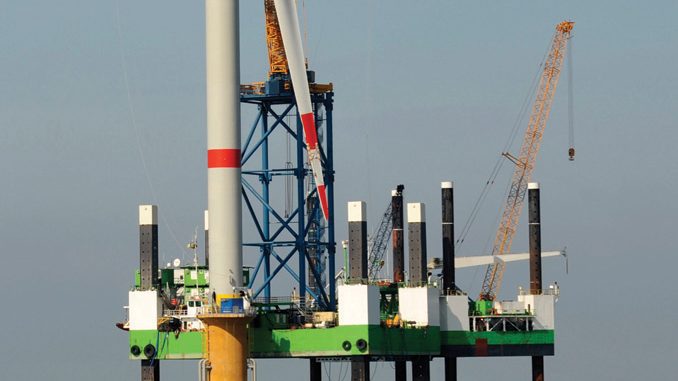
Owing to its vast coastline of about 7,600 km, India has an estimated offshore wind power potential of 350 GW. According to the Lawrence Berkeley National Laboratory, the country’s total technically feasible offshore potential at 100 metre hub height is about 238 GW with a minimum capacity factor of 21 per cent. As per another set of estimates, Gujarat has an offshore wind potential of around 106 GW while Tamil Nadu has 60 GW. To harness the potential along the country’s coastline, the Ministry of New and Renewable Energy (MNRE) released the National Offshore Wind Energy Policy in October 2015.
In November 2017, the Facilitating Offshore Wind in India (FOWIND) consortium commissioned the country’s first offshore light detection and ranging (LiDAR) device for the National Institute of Wind Energy’s (NIWE) platform in the Gulf of Khambhat for the collection and measurement of wind speed data. In April 2018, the MNRE invited expressions of interest (EoIs) for India’s first offshore wind energy project of 1,000 MW.
Project details
The competitive bidding route will be adopted for the selection of developers and allocation of capacity in the offshore wind power segment. As per the notification for EoIs, both domestic and global wind companies are eligible for participation, although their qualifying parameters vary. Only those global entities that have experience in installing at least 500 MW of offshore wind projects can participate. Also, only those domestic companies can submit EoIs that have developed at least 500 MW of onshore wind power capacity and have partnered with either global offshore wind turbine manufacturers or global developers with experience of more than 500 MW of offshore wind projects. Moreover, the qualifying entities should have an average annual turnover of at least Rs 5 billion for the past three years. The last date for submitting the bids is May 25, 2018.
The proposed project will be set up in Zone B of FOWIND located 23-40 km off the Gujarat coast in the Gulf of Khambhat, on the seaward side of Pipavav port, also accessible from Jafrabad port. The wind resource assessment study is being carried out by the NIWE using the recently installed LiDAR device and the 100 metre wind mast installed on the Jafrabad coast. However, complete LiDAR data will be available only by November 2018.
Offshore wind development challenges
Offshore wind power is significantly more expensive than onshore wind, with a turbine accounting for 45-50 per cent of the project cost. Foundation structures, evacuation facilities and project management account for the remaining cost. The foundation structures used in offshore wind projects (depending on water depths and piling capacities), equipment for different submarine soil conditions, and transportation of large fabricated segments/components through special vessels entail high costs, making the projects capital intensive.
Further, for offshore wind power development, it is critical to obtain the requisite clearances from military authorities, port authorities, coastguards and other governmental agencies, and oil and telecommunication companies, in a time-bound manner. Inadequate grid infrastructure also poses a significant challenge for offshore connectivity. Connecting offshore wind farms to the inland grid network depends on several factors such as distance to coast, cable routing options and subsea cabling.
The risks and uncertainties associated with offshore wind projects could also impact the availability of low-cost financing for the segment. The government, therefore, has a significant role to play in promoting offshore wind development in India, until the market achieves scale and gains maturity.
Outlook
With the development of the 1,000 MW offshore wind power project, the country will move towards its target of installing 5,000 MW of offshore wind capacity over the next five years. Competitive bidding is expected to keep tariffs low and enable better power offtake. However, given the various risks and costs associated with the projects, tariffs are likely to remain higher than onshore wind.
Global technological developments have reduced the cost of offshore wind, particularly in China and the North Sea region. In many countries, recent tenders for offshore development have seen record low bids. For example, the 600 MW project in Danish waters saw a record low bid of Euro 0.049 per kWh ($0.55 per kWh), as against the global levellised cost of energy of $0.03 per kWh for onshore wind in 2016-17. The unprecedented decline in costs is good news for countries like India, which are currently foraying into the offshore segment. This is expected to drive capacity addition and help achieve the MNRE’s offshore wind targets by 2022.
